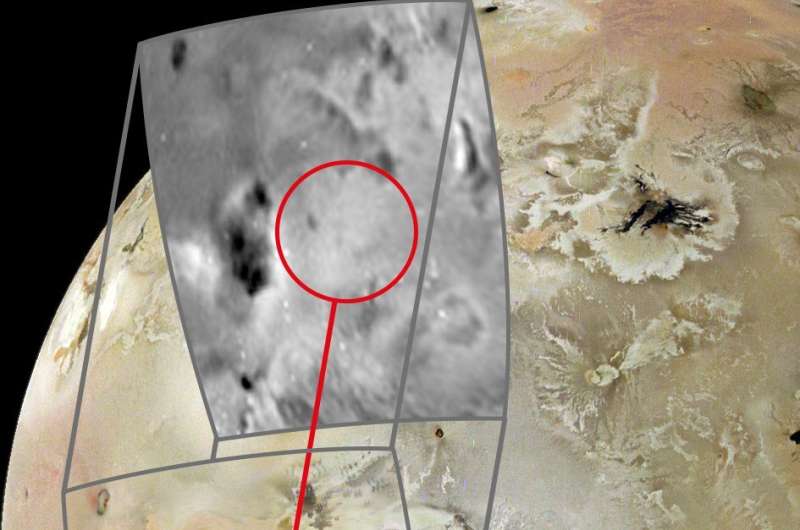
Comparison of JunoCam data from April 2024 with imagery from the Galileo mission of the same area in November 1997 (greyscale insert) reveals a new volcanic feature on the surface of Jupiter’s moon, Io. Credit: NASA/JPL-Caltech/SwRI/MSSS/Europlanet
A new volcano has been spotted on Jupiter’s moon Io, the most geologically active place in the solar system. Analysis of the first close-up images of Io in more than 25 years, captured by the JunoCam instrument on NASA’s Juno mission, shows the emergence of a fresh volcano with abundant lava flows and volcanic deposits covering an area of approximately 180 kilometers by 180 kilometers. The findings were presented at the Europlanet Science Congress (EPSC 2024) in Berlin this week.
The new volcano is located just south of Io’s equator. Although Io is covered in active volcanoes, images taken during NASA’s Galileo mission in 1997 did not detect a volcano in this particular region—just a featureless surface.
“Our recent JunoCam images show many changes on Io, including large, complex volcanic features that appear to have formed from nothing since 1997,” said Michael Ravine, Advanced Projects Manager at Malin Space Science Systems, Inc. , who designed, built and operates JunoCam for the NASA Juno Project.
The eastern side of the volcano is stained a diffuse red from sulfur that the volcano ejected into space and fell back onto Io’s surface. On the western side, two dark streams of lava erupted, each flowing for about a hundred kilometers.
At the farthest point of the flows, where the lava accumulated, the heat caused the frozen surface material to vaporize, forming two overlapping gray circular deposits.
The best JunoCam image of this feature, east of an existing volcano called Kanehekili, was taken on 3 February 2024 from a distance of 2,530 kilometers and at a scale of 1.7 kilometers per pixel. The images were captured on the night side of Io with illumination coming only from Jupiter.

A side-by-side comparison of JunoCam data from April 2024 (left) with Galileo spacecraft imagery of the same area in November 1997 (right), reveals a new volcanic feature on the surface of Jupiter’s moon, Io. Credit: NASA/JPL-Caltech/SwRI/MSSS
This encounter was one of three recent flybys of Io in 2023 and 2024, during which JunoCam captured about 20 close-up visible color images. JunoCam observed a total of nine plumes associated with active volcanic features on the moon, as well as other changes, such as new lava flows and other surface deposits.
JunoCam data is posted on the mission’s website after being received on Earth to allow the public to create images of Jupiter and its moons.
“JunoCam images are created by people from all walks of life, providing a way for anyone to join our science team and share in the excitement of space exploration,” said Scott Bolton, the principal investigator of NASA’s Juno mission at the Southwest Research Institute.
Provided by Europlanet Media Center
Quote: JunoCam spots new volcano on active Io (2024, September 11) retrieved September 12, 2024 from https://phys.org/news/2024-09-junocam-volcano-io.html
This document is subject to copyright. Except for any fair dealing for the purpose of private study or research, no part may be reproduced without written permission. The content is provided for informational purposes only.
#JunoCam #detects #volcano #active